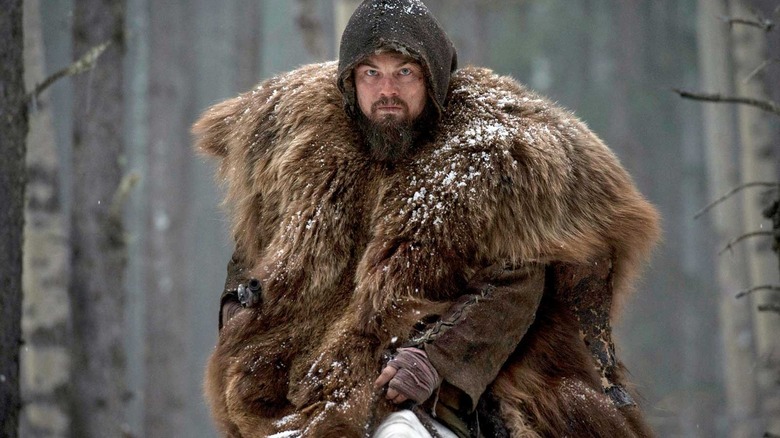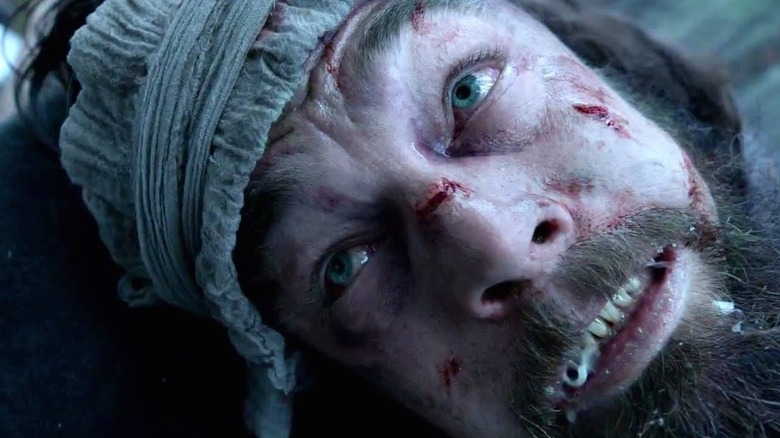
Leonardo DiCaprio began his film career at age 17 in Kristine Peterson's 1991 film "Critters 3," a harrowing tale of corrupt real estate exploitation. In "Critters 3," DiCaprio played Josh, the precocious teenage stepson of a morally bankrupt slumlord, a stepfather he accidentally sentences to death when Josh locks him in a basement room with a ravenous Tasmanian devil from space. From "Critters 3," DiCaprio went on to be nominated for seven Academy Awards across the categories of Best Supporting Actor, Best Actor, and Best Picture (he served as a producer on 2013's "The Wolf of Wall Street").
DiCaprio's one Academy Award win was for Alejandro González Iñárritu's 2015 frontier thriller "The Revenant," in which he played Hugh Glass, a guide in The Dakotas in 1823, who is mauled horribly by a grizzly bear and left for dead by a fellow trapper played by Tom Hardy. The bear in the mauling scene was not present on screen, but was the result of expert CGI provided by Industrial Light and Magic. A scene later in the film, however, wherein Hugh Glass had to cut open and climb inside a bear carcass for warmth ... that was stirringly real.
In a 2015 interview with Yahoo, DiCaprio -- who recently had a tree named after him -- details which parts of "The Revenant" were staged, and which parts were un-simulated ... and harrowing to film.
The Difficult Shoot

DiCaprio was eager to take on some physically taxing challenges to play Hugh Glass, and the bear attack wasn't even one of the more difficult ones. Since the bear was realized with CGI, DiCaprio had to be connected to a complicated cable system to throw him around as a bear might. Much of the difficulty stemmed from the natural environments where Iñárritu, DiCaprio, and cinematographer Emmanuel Lubezki shot "The Revenant." Much of the film was photographed in Canada and Argentina in very inclement conditions, causing some of the film's crew to walk off the set. The abandonments and the global search for natural snow cause the film to go way over budget. Additionally, since Lubezki was shooting only using natural light, filming could only occur for a few hours each day, and there were a lot of communication problems around the set from producer Jim Skotchdople. What's more -- and Iñárritu has copped to this -- the crew complained that there was a lack of clarity from Iñárritu himself. A lot of last-minute changes and hasty alterations to scenes made shooting all the more grievous.
A lot of this difficulty stemmed from Iñárritu's insistence that as little CGI as possible be used. He and DiCaprio wanted "The Revenant" to look incredibly natural and authentic. DiCaprio was so devoted to this aesthetic -- to tap into the primal nature of the natural world -- that he put himself through a few horrible experiences.
The frozen rivers were indeed frozen rivers, and DiCaprio had to splash through several of them during the shoot. Shooting in a remote location means a lack of comfort for everyone, so if it looked like DiCaprio was freezing, he was.
The Bear Carcass

In one scene, Hugh Glass is facing a frozen night, and, in order to stay warm, has to climb inside the carcass of a dead animal for warmth. Children raised on "The Empire Strikes Back" will recognize this practice. DiCaprio has been coy about what kind of animal he climbed inside of -- some sources have reported it was a horse, others a bear -- but that he did indeed climb inside a real carcass for warmth. When one is struggling to merely stay alive, your gag reflex is likely one of the first things to go.
Although maybe not. In another scene, Hugh, starving to death, comes upon a bison. With little choice in his current diet, Hugh eats the animal's liver. DiCaprio elected to eat raw bison liver on camera, and his reaction is quite real. While experiencing the ecstatic truth of a man literally choking back raw organ meat carries with it a certain sense of fun, all the retching tips DiCaprio's performance away from authenticity in that moment; an experienced wilderness guide like Hugh Glass would not have choked and gagged on animal liver, but would have been used to the flavor.
Still, one must admire DiCaprio for his tenacity.
One can argue whether or not such harrowing physical trials are required for a great performance -- and indeed, some actors prefer to challenge themselves in extreme ways -- but DiCaprio's choice to struggle, along with Iñárritu's and Lubezki's insistence on naturalness, eventually led all three of them to win Academy Awards for "The Revenant." Sometimes, it seems, you really do have to suffer for your art.
Read this next: Clint Eastwood's 14 Best Roles Ranked
The post The Revenant's Bear Carcass Scene Was More Real Than You Think appeared first on /Film.
0 Comments